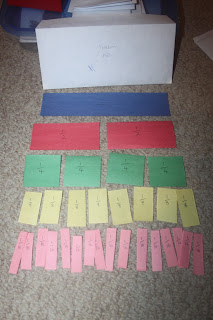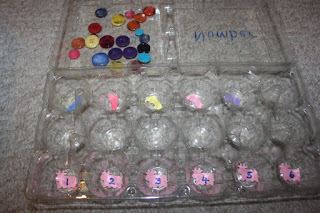Although I enjoy the concept of Montessori and kids learning through play based activity, there is no doubt its an expensive way to teach if you are to use the official items. Fortunately with the help of Pinterest and a little imagination, a Montessori inspired learning environment can be created on a shoe string. Please see a few of our 'games' below that I created for my elementary age daughter:
Picture match Up - Horizontal, Vertical, Oblique:
Paper
Printer
Pen
Envelope
Cut out pictures that represent horizontal, vertical, oblique. Write a heading on a blank sheet of paper.
Object to place the pictures under the correct heading
Atonym, Homophone and Synonym Sort
Paper
Pen
Printer
Envelope
You can find these word groups to print free online. Print each category and place in envelope ready for use.
Object to match words based on category to develop vocabulary and understand how words relate to one another.
Fraction set:
Construction paper in various colors
Pen
Envelope
Cut one color to form your "whole' (write 'whole' on one side and the divide sign on the other side) , then cut the next different colored sheet of the same size in half to form halves (write 1/2 on each half), Next cut another different colored sheet in half and then each half in half again to form quarters (write 1/4 on each piece of paper), Next create eigths and then sixteenths in the same manner as seen in the picture.
Object for the child to understand how each fraction relates to the whole, also to understand division of a whole.
Famous Artist Sort:
Paper
Printer
Envelope
In this example we had studied Van Gough and Edgar Degas. I printed off various paintings, quotes and facts about each artist and their painting style
Object for the child to think about painting styles and identify artists works, understand the artist and learn basic information about them
Telling Time:
 Paper
Paper
Printer
colored markers
envelope
popsicle sticks
Print a blank clock face
Write the numbers 1 through 12 in one color on squares of paper. Write 13 through 24 in another color on squares of paper. then write 5 minute segments (5,10,15,20 etc.) up to 60 in another color on squares of paper. Place 5 dots on each popsicle stick.
To use this explain that the earth travels around the sun and it takes 24 hours to do so (use visual props such as two balls) and that 24 hours is one full day.
Next explain that a clock is used to measure the number of hours in the days... ask them to place the numbers 1 through 12 on the clock in the correct places.
Explain that a clock has to go around twice to complete a full day or 24 hours. Get the child to place the numbers 13 through 24 on top of the first set of numbers.
Next tell them that the small hand on a clock (you can use popsicle sticks or draw on the hands) shows the hour of the day and the long hand shows the minute. In every hour the long hand goes around the clock one time. Have them place the number segments 5 through 60 on the clock to show that each time the long hand reaches a number, 5 minutes passes. Have them count 5 up in 5's to 60. Finally use the popsicle sticks to lay between numbers to show minutes. Have them count the dots between.
Famous People in History Fact Match:

Paper
Printer
I found these printable cards at http://researchparent.com/20-historical-figures-worth-knowing/
Print out and cut into sections
The object is to learn about and begin to recognize famous historical figures.
Story Sticks:
Colored markers
Popsicle sticks
Write any number of words on popsicle sticks. We have divided ours into verbs, nouns and what we call 'wow' words. The child chooses 3-4 sticks in a variety of colors and then must tell or write a story using the words chosen.
The object is to inspire creative writing, story telling and increase vocabulary.
As you can see I have created a large number of sorting games. This IS NOT all we do that is inspired by Montessori principles but it is where I have started as so many things can be 'sorted' and the process encourages the child to think about what they are doing, apply logic, it encourages observation and overall breaks otherwise more difficult tasks down into simple steps.
The total cost for the above activities was approximately $3, this includes the ink, paper and popsicle sticks used.
Picture match Up - Horizontal, Vertical, Oblique:
Paper
Printer
Pen
Envelope
Cut out pictures that represent horizontal, vertical, oblique. Write a heading on a blank sheet of paper.
Object to place the pictures under the correct heading
Atonym, Homophone and Synonym Sort
Paper
Pen
Printer
Envelope
You can find these word groups to print free online. Print each category and place in envelope ready for use.
Object to match words based on category to develop vocabulary and understand how words relate to one another.
Fraction set:
Construction paper in various colors
Pen
Envelope
Cut one color to form your "whole' (write 'whole' on one side and the divide sign on the other side) , then cut the next different colored sheet of the same size in half to form halves (write 1/2 on each half), Next cut another different colored sheet in half and then each half in half again to form quarters (write 1/4 on each piece of paper), Next create eigths and then sixteenths in the same manner as seen in the picture.
Object for the child to understand how each fraction relates to the whole, also to understand division of a whole.
Famous Artist Sort:
Paper
Printer
Envelope
In this example we had studied Van Gough and Edgar Degas. I printed off various paintings, quotes and facts about each artist and their painting style
Object for the child to think about painting styles and identify artists works, understand the artist and learn basic information about them
Telling Time:
 Paper
PaperPrinter
colored markers
envelope
popsicle sticks
Print a blank clock face
Write the numbers 1 through 12 in one color on squares of paper. Write 13 through 24 in another color on squares of paper. then write 5 minute segments (5,10,15,20 etc.) up to 60 in another color on squares of paper. Place 5 dots on each popsicle stick.
To use this explain that the earth travels around the sun and it takes 24 hours to do so (use visual props such as two balls) and that 24 hours is one full day.
Next explain that a clock is used to measure the number of hours in the days... ask them to place the numbers 1 through 12 on the clock in the correct places.
Explain that a clock has to go around twice to complete a full day or 24 hours. Get the child to place the numbers 13 through 24 on top of the first set of numbers.
Next tell them that the small hand on a clock (you can use popsicle sticks or draw on the hands) shows the hour of the day and the long hand shows the minute. In every hour the long hand goes around the clock one time. Have them place the number segments 5 through 60 on the clock to show that each time the long hand reaches a number, 5 minutes passes. Have them count 5 up in 5's to 60. Finally use the popsicle sticks to lay between numbers to show minutes. Have them count the dots between.
Famous People in History Fact Match:

Paper
Printer
I found these printable cards at http://researchparent.com/20-historical-figures-worth-knowing/
Print out and cut into sections
The object is to learn about and begin to recognize famous historical figures.
Story Sticks:
Colored markers
Popsicle sticks
Write any number of words on popsicle sticks. We have divided ours into verbs, nouns and what we call 'wow' words. The child chooses 3-4 sticks in a variety of colors and then must tell or write a story using the words chosen.
The object is to inspire creative writing, story telling and increase vocabulary.
The total cost for the above activities was approximately $3, this includes the ink, paper and popsicle sticks used.


















